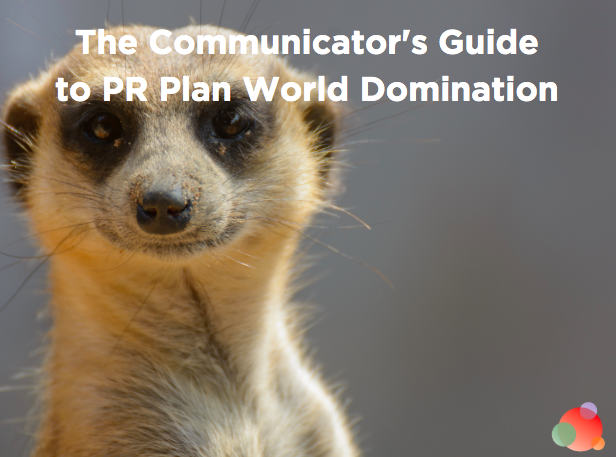 It’s planning season!
It’s planning season!
Communicators know that as soon as Labor Day is a thing of the past, our world picks up speed at a superhero-style pace.
Prospects who ghosted you months ago, call.
Business development picks up.
Proposals are requested.
RFPs are served-up.
(And if you wish you never had to respond to another RFP again, read this –> Scale Your Agency Without Proposals or RFPs.)
And it’s planning time for your clients, your organization, and/or your own PR firm.
Communicators have a lot going on.
It can feel overwhelming at best.
But as overwhelming as planning season can seem, it is also one of the most crucial times of the year.
This is the time of year communicators can shine.
We can grab our place at the leadership table by being a key part of the future growth and success of the organizations we work for and with.
Likewise, now is the time we can stop being the cobbler’s children, running around shoeless, and put together a plan for our own agencies.
Imagine that?
Actually having a plan to grow your agency (one that’s not based on the hope strategy).
To help you in these quests, we’ve compiled some of our most popular planning posts to provide a ‘plan’ of action.
Start Here to Build Your Communications Plan
Sometimes you just need a roadmap.
You need someone to say to you, “Hey you, do this!”
Then you can put your brainpower into the doing versus figuring out the how and what to do.
If that’s what you need, then this article is the best place to start.
We review the GSOT and walk you through the process of creating an effective and measurable plan for your business.
What’s the GSOT, you ask?
Sadly, it’s not a sequel to Game of Thrones. But it is a process crucial to communications planning:
- Goals
- Strategy
- Objectives
- Tactics
A Plan Consists of More Than Tactics
These are the building blocks for your communications plan.
And if you want to develop an effective one, you need to understand what they are, how they are different, and how they work together.
The funny thing about GSOT is that most people have heard of them or *think* they implement them correctly.
But a good percentage actually do not.
It ends up that most people just like to find five different ways to describe tactics and pretend they are addressing the other pieces.
Tactics are important, but without laying out the goals, objectives, and strategies that drive them it’s like putting together a puzzle with a couple of pieces from a bunch of different kits.
It doesn’t make sense, it doesn’t fit together, and it’s not effective.
That’s why this article is your next step (after reading the one above).
Even if you are a veteran at planning, refresh yourself on the GSOT and the best way to use it to build your plan.
Sixteen Things to Discuss at the Leadership Table
Now that you have your a roadmap, we help you fill in the landmarks with 16 things every communications plan should have.
These items are necessary for a plan that positions communications at the leadership table.
So if that’s not where you want to be, you should skip this article.
Protect Your Communications Plan Against the Forces of Evil
I’m not going to lie the best thing about this article is the image of Darth Vader.
But you’ll also learn how to protect your PR Plan from the forces of eviiiiiiiil…muahahhaha.
But really.
There are a lot of factors that can derail even the best communications plan.
In this article, we go over the ones we see most commonly with our agency owner clients (and have dealt with ourselves).
This includes:
- Working in the proper context
- Picking the right team
- Understanding your technology opportunities and constraints
- Working with limited budgets
- Navigating environmental factors
PR Plan Dos and Don’ts
Consider this blog post your dos and don’ts checklist for the things you need to be aware of to definitely do and definitely not do.
Some of these might seem like common sense, and some are things you know you need but forget in the heat of the moment.
This includes details and how-tos around some of the following:
Dos:
- Create goals and objectives tied to business results
- Use the four media types
- Just say no to organizational silos
- Create a clear messaging and personality document
And don’ts:
- Rely exclusively on earned media
- Focus on ego versus results
- Try to be everywhere
- Have an extraneous strategy ADD (oh look, a bird)
Even more importantly, this post discusses how to talk to your clients or organizational leaders about these things.
Which, let’s be honest….is sometimes the most challenging part.
You know what you need to build an effective communications plan, but you need to mesh that knowledge with the perspective or short-term demands of an organizational leader or client who only understands part of the equation.
Have no fear, this article is here to help.
Do You Even PESO?
And then it all comes down to the PESO model.
If this is the first time you’ve build a PR plan using the PESO model, then you’ll want to review our PESO model series.
You can find all of those articles below.
Ready, Set, Plan
And now you have the building blocks to create a rockstar level communications plan for yourself or your clients.
Go forth and plan!